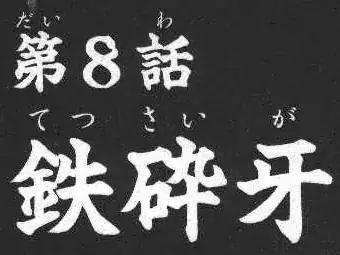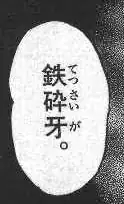I've been watching Inuyasha with subtitles and in episode 6 and 7, Inuyasha fights with his brother Sesshomaru about a sword. The English subtitle says "Tetsusaiga" but they're clearly saying "てっさいが". Why are they subtitling it in this way?
-
5This is a mistranslation: there's a small "tsu", which means there should be a double consonant there (て**っ**さいがい - te-**s**-sa-i-ga). So instead of Te**s**saiga, they mistranslated to Te**tsu**saiga, as if the "tsu" (っ) were not a small one. – JNat May 09 '15 at 12:46
-
So they made their translation by reading the script and never bothered watching the show? – virmaior May 09 '15 at 13:20
-
They probably mistook the small "tsu" for a big one. Read the first two paragraphs [here](http://en.wikipedia.org/wiki/Tsu_%28kana%29) for a general overview of what I meant. But basically, the big "tsu" is read as "tsu", and the small one is used to denote [consonant gemination](http://en.wikipedia.org/wiki/Sokuon). So... yeah, they probably didn't hear the word being said, and only went from the transcript. – JNat May 09 '15 at 13:58
-
I don't misunderstand what they did ... I am asking how in their process they completely missed the pronunciation. – virmaior May 09 '15 at 14:17
-
1What is the source of the sub you watch? I mean the company which translate and distribute the anime. – nhahtdh May 09 '15 at 15:48
-
5@nhahtdh I don't know about the OP, but this mistake was in the official US translation by Viz when I watched the show back in 2001, so it's not just something that some scuzzy bootlegging group does. – Torisuda May 09 '15 at 17:59
-
3In fact, the dub actors even pronounced the word with a 't' in it as "Tetsaiga". – Torisuda May 09 '15 at 18:01
-
2@virmaior I don't know what the deal is specifically with Inuyasha, but anime simulcasters in recent times indeed often have to translate off of a script without access to the audio/video until the last minute. Granted, I would _think_ that this is just because of the exigencies of simulcasting, which shouldn't have had any relevance back in the early 2000s... – senshin May 09 '15 at 22:51
-
@Torisuda In that case I'd change my above statment from "this is a mistranslation" to "this _may be_ a mistranslation". I've never watched/read Inuyasha, so I was just going from my (very) basic knowledge of Japanese and the kana posted on the question by the OP. – JNat May 10 '15 at 02:00
-
@JNat Granted, I was watching the dub, and it was over ten years ago, but I don't remember anything from the show that would have helped resolve this question. Until Logan posted his answer, I figured you were probably right that it was a mistranslation; it's less likely with an official translation, but official translators make mistakes too. – Torisuda May 10 '15 at 03:18
-
The manga does *not* use a small っ. It may be possible to confuse the character in a horizontal heading (since つ is generally shorter than most kana), but it the vertically-written speech bubbles, it's clear that the furigana read てつさいが. – pyrocrasty Apr 04 '17 at 17:11
2 Answers
While it's tempting to chalk this up to a mistranslation by Viz, as Ross Ridge's answer suggests (and that Viz themselves might even admit to), I think if we take the question as seriously as possible, the answer must be that both names are correct, at least in writing.
The relevant background here is that Inuyasha takes place in the Sengoku period roughly 500 years ago. So Inuyasha's sword's name should be interpreted in the Japanese of the time, not modern Japanese.
On the other hand, the use of っ in Japanese is a relatively modern invention. The earliest known uses of it in this way occurred in the 19th century, and it wasn't standardized until 1947. Prior to this, double consonants in Japanese existed only as common slurs where only the consonant was pronounced. This form of slurring has existed for a long time, likely since the Sengoku period. I suggest reading this Japanese SE question for more information.
So, while 鉄砕牙 would have been written out as 「てつさいが」 in the classical Japanese of the time (or possibly in several other ways, as hiragana themselves were not standardized until 1900 with the removal of hentaigana), it could plausibly be pronounced as either 「てつさいが」 (tetsusaiga) or 「てっさいが」 (tessaiga) to the modern Japanese ear. But the classical Japanese speaker would have recognized these as the same word. Even this is something of a simplification, as pronunciation of these syllables has shifted over time, but without having audio records of Japanese from that time it's fairly difficult to know exactly what shifts have occurred.
That is to say, while tessaiga and tetsusaiga sound rather different to us, there isn't any distinction between the two in period Japanese writing, in the same way that "sorta" is just a slurred version of "sort of" in English. They're both valid romanizations of the same word, and so they're both really the same name. In some sense, saying that either tessaiga or tetsusaiga is correct is actually historically inaccurate. In modern Japanese, it's clear that they say tessaiga, but that doesn't really mean that tetsusaiga is an incorrect way of writing the name.
I guess the real reason for this confusion is that the text has gone through so many different linguistic steps that it would necessarily end up being somewhat confused. Of course the text is written in modern Japanese, but it's supposed to be a modern interpretation of historical Japanese. In order to romanize it, since there's no way to romanize classical Japanese, it first needs to be converted back into modern Japanese, and then to roumaji (which approximate Japanese pronunciation using latin alphabet characters). But the conversion back to modern Japanese is ambiguous, and so both tessaiga and tetsusaiga could be simultaneously valid.
With all that said, I don't think Inuyasha tries especially hard to stick to historically accurate Japanese, so to some degree this is a moot point. I just wanted to point out that, strictly speaking, in Sengoku-period Japanese, there is no way to differentiate the two words. On the other hand, for practical purposes, one can hear that the anime uses tessaiga for pronunciation and writes てっさいが as the furigana, so presumably this is the more understandable choice in English.
The reason why the subtitles don't match the dialog is apparently because Viz wanted to be consistent with their earlier translation of the Inuyasha manga. In the manga it's not at all clear that the sword should be named tessaiga (てっさいが) instead of tetsusaiga (てつさいが). It's a made up name whose kanji (鉄砕牙) could be pronounced either way. There's furigana in manga to show the author's intent but it doesn't make the tsu character clearly smaller:


I found the above pictures in a Tumbler post that goes into more details about the mix up.
It seems it wasn't until the release of the anime that Viz had any reason to believe they were wrong, and I guess they decided it would be better to be consistent with their manga translation than the Japanese audio.
(I have to say though that all this makes me wonder if the producers of the anime version were just guessing as well.)
- 1,674
- 14
- 21
-
1The つ in the left-picture is ambiguous, but the one on the right is clearly not a small つ. Maybe the subtitles have it correct, and it's whoever wrote the script for the anime audio who got it wrong. – BlueRaja - Danny Pflughoeft May 10 '15 at 05:43
-
3Note that in the traditional typographical convention in Japan they do not use small kana in hurigana. Consequently if the publisher sticked to this convention you can't tell the author's intention from the hurigana. – Pteromys May 10 '15 at 07:30
-
1The tumbler post argues that the right-hand image says てつさいが because the manga doesn't use small kana in furigana. This is partially true. Small furigana are used, but not always. Smaller writing, especially, never uses them. Larger writing often does, but not consistently. Also, small furigana can be hard to tell from large ones... and sometimes a large kana will be smaller than it should... It does make things confusing. Still, small っs seem to be the easiest of the small kana to distinguish in Inuyasha, and 鉄砕牙 is always written てつさいが, not てっさいが. – pyrocrasty Apr 04 '17 at 18:09